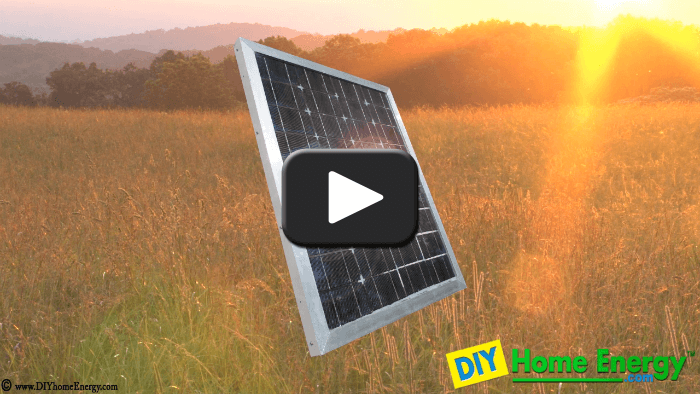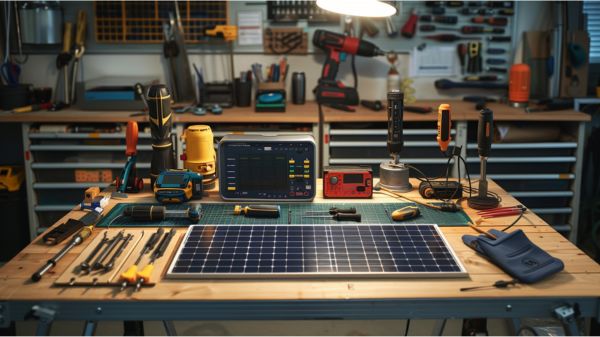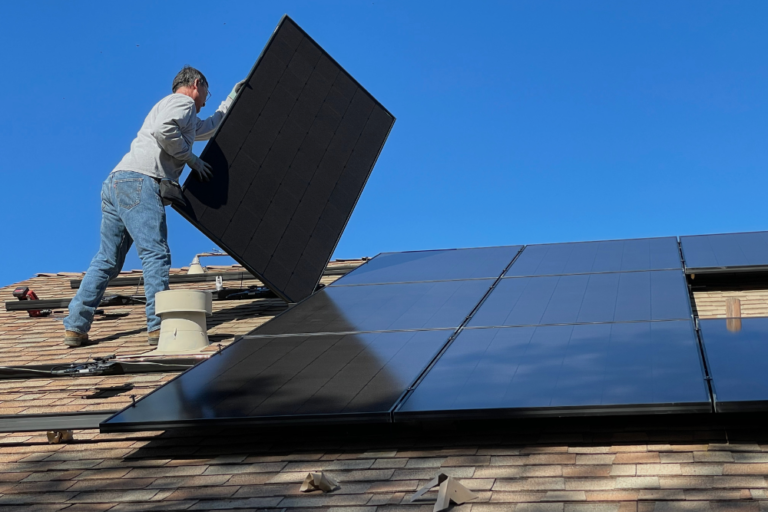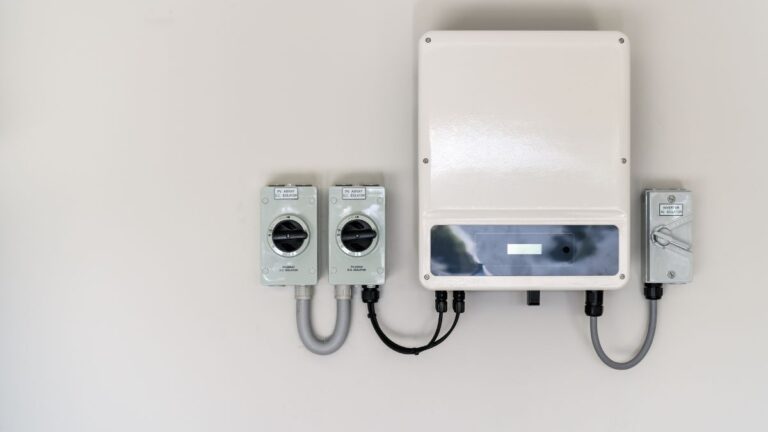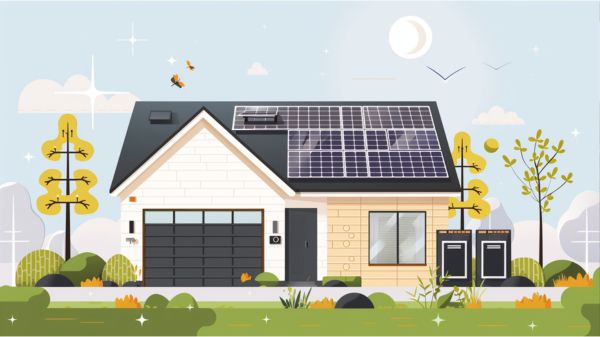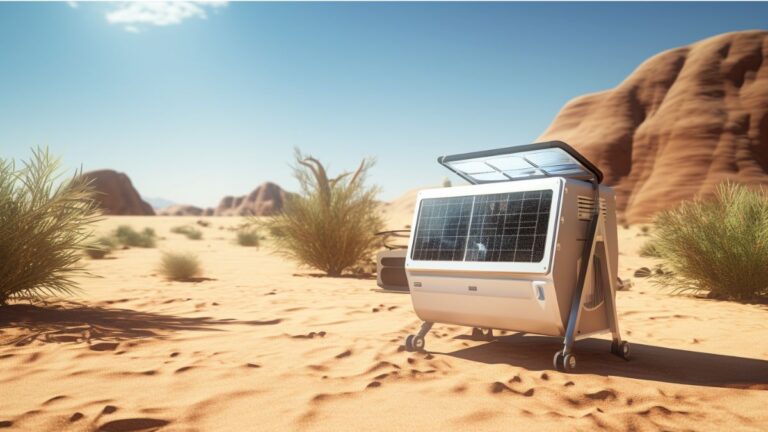10 Best Components for Off-Grid Solar Systems
Looking to break free from the clutches of the utility grid and embrace the power of the sun? Look no further! We’ve got the inside scoop on the 10 best components for off-grid solar systems.
These amazing components will open the door to a world of self-sufficiency and belonging. Picture yourself generating and storing your own electricity, powering your home, cabin, or vacation property with ease.
With solar panels, charge controllers, inverters, battery banks, and more, you’ll have everything you need to create a reliable and efficient off-grid solar system.
Get ready to join the ranks of those who have achieved energy independence and feel the belonging that comes with it. Let’s dive in!
Solar Panels
When selecting the best solar panels for your off-grid system, consider the efficiency, cost, and system load requirements.
Solar panels are the heart of your off-grid solar system, as they’re responsible for converting sunlight into usable energy. The efficiency of the panels is crucial, as it determines how much power can be generated from a given amount of sunlight. Higher efficiency panels will produce more energy, allowing you to charge your batteries faster and meet your system load requirements.
Additionally, cost is an important factor to consider. While more efficient panels may have a higher upfront cost, they can save you money in the long run by maximizing the energy production of your system. Therefore, it’s essential to strike a balance between efficiency and cost when selecting your solar panels for an off-grid solar system.
Charge Controllers
To ensure efficient energy management in your off-grid solar system, you’ll need a charge controller. A charge controller serves as a crucial component in off-grid solar power systems, ensuring the proper flow of energy from the solar panels to the battery.
Here are four important things to know about charge controllers:
- Types: There are two main types of charge controllers – MPPT and PWM. MPPT controllers are more efficient and can capture the highest amount of power from solar panels, while PWM controllers use pulse modulation and have limited input compared to MPPT.
- Functions: Charge controllers prevent battery overcharging by regulating the voltage from the solar array. They also eliminate reverse current flow from the batteries back to the solar panels, protecting the overall system.
- Inverter Compatibility: When selecting a charge controller, ensure it’s compatible with your inverter and other system components to ensure smooth operation and optimal energy conversion.
- Battery Bank: Consider the type of battery bank you have, such as a lithium battery bank, as certain charge controllers may be better suited for specific battery chemistries.
Inverters
One important component for your off-grid solar system is the inverter, which converts DC energy stored in the battery into usable AC power for your appliances.
When selecting an inverter, it’s crucial to consider the size of the inverter in relation to the maximum load it will handle. Additionally, the voltage of the inverter must match the battery voltage for optimal efficiency.
To ensure the highest quality power output, it’s recommended to choose a pure sine wave inverter. This type of inverter provides a clean and stable power supply, suitable for sensitive electronics.
Inverter/chargers offer a dual functionality by combining inverter capabilities with battery charging features. They also allow for the integration of an external power source, such as a backup generator, providing flexibility and redundancy.
Consider using MPPT solar charge controllers to enhance the efficiency of your off-grid solar system, especially when using sealed lead-acid batteries or flooded lead-acid batteries.
Deep-Cycle Batteries
For optimal performance and reliability in your off-grid solar system, you’ll need to select the best deep-cycle batteries. Deep-cycle batteries are specifically designed for energy storage in off-grid solar systems.
Here are four key factors to consider when choosing deep-cycle batteries for your system:
- Battery Chemistry: Lithium batteries, specifically lithium iron phosphate (LiFePO4) batteries, are a popular choice for off-grid solar systems. They’re maintenance-free, have a longer lifespan, and don’t emit gases.
- Voltage Variations: Lithium batteries are available in 12v, 24v, and 48v variations, providing flexibility in system design. These batteries can be easily connected in parallel to meet the energy storage requirements of your off-grid solar system.
- Long-Term Reliability: Reputable manufacturers of lithium batteries typically offer warranties of around 10 years. This ensures long-term reliability and peace of mind for your off-grid solar system.
- Maintenance and Ventilation: Deep-cycle lead-acid batteries are an alternative option, but they require regular maintenance and proper ventilation due to the emission of gases.
Choosing the right deep-cycle batteries is crucial for efficient energy storage in off-grid solar systems, ensuring that you have a reliable power source even when disconnected from the grid.
Mounting and Racking Systems
Now let’s talk about the different types of mounts, the installation challenges they may present, and the importance of durability and maintenance when it comes to mounting and racking systems in off-grid solar systems.
Choosing the right type of mount, whether it’s roof, pole, or ground, is crucial for optimizing energy production. Additionally, installation challenges such as roof angle and structural integrity must be considered to ensure a secure and efficient system.
Types of Mounts
Choose the ideal mounting configuration for your off-grid solar system to ensure optimal energy production and secure placement of solar panels. When considering the types of mounts for your off-grid solar system, there are a few options to choose from:
- Roof mount: This option allows you to mount the solar panels directly onto your roof. It’s a popular choice for homeowners who have limited space.
- Pole mount: If you have a large open area, a pole mount may be the best option for your off-grid solar system. It allows you to mount the panels on a pole, which can be positioned to capture the maximum amount of sunlight.
- Ground mount: Ground mounts offer flexibility and efficiency for off-grid solar systems. They can be angled to optimize energy production and are suitable for larger installations.
- Linear ground mount: This type of ground mount allows you to adjust the angle of the solar panels for optimal energy production. It’s a great option for off-grid systems that require DIY installation.
Consider these types of mounts when designing your off-grid solar system to ensure the best placement and energy production for your solar components.
Installation Challenges
To overcome installation challenges in off-grid solar systems, ensure proper mounting and racking systems are in place. These systems play a crucial role in securely holding solar panels and optimizing their performance.
When choosing mounting options, consider the type of mount that best suits your needs, such as roof mount, pole mount, or ground mount. Linear ground mounts are particularly adjustable, allowing for maximum energy production. Additionally, take into account the system’s location and darker winter months to ensure maximum efficiency.
It’s important to select racking systems that are compatible with the solar panel mounts and provide sufficient support. This will help prevent any damage to the panels and ensure their longevity.
Durability and Maintenance
Ensure the durability and longevity of your off-grid solar system by properly maintaining the mounting and racking systems. Here are some key considerations for maintaining these crucial components:
- Regular inspections: Conduct routine inspections of the mounting and racking systems to identify any signs of wear, corrosion, or damage. Replace any faulty or damaged components promptly to prevent further issues.
- Cleaning: Keep the solar panels clean to maximize energy efficiency. Regularly remove dirt, debris, and snow to ensure optimal performance. Use a soft brush or cloth and mild detergent to clean the panels gently.
- Lubrication: Apply lubricant to moving parts of the mounting and racking systems, such as hinges and bolts, to prevent rust and ensure smooth operation. Check the manufacturer’s guidelines for suitable lubricants.
- Seasonal adjustments: Adjust the tilt angle of the solar panels according to the season to maximize energy production. Optimal tilt angles vary based on location and solar panel type, so consult a professional for guidance.
Wiring and Cables
When wiring and installing cables for your off-grid solar system, it’s important to properly size and connect them to ensure efficient energy flow. The wiring and cables play a crucial role in connecting the various components of your system, such as the solar panels, charge controllers, and batteries.
To maximize the power output of your system, it’s recommended to use high-quality cables with appropriate gauge sizes. For example, lithium batteries require thicker cables to handle the high currents they can deliver.
Additionally, a battery management system should be installed to monitor and protect the batteries from overcharging or discharging.
It’s also important to consider the life expectancy of the cables, as they’ll be exposed to extreme weather conditions when installed on a roof mounted off-grid solar system.
Monitoring Systems
Maximize the efficiency and performance of your off-grid solar system by integrating a monitoring system that provides real-time data on energy generation and usage. A monitoring system offers several benefits for your off-grid solar system:
- Early Detection: With real-time data on energy generation and usage, you can detect any issues or underperformance early on. This allows for timely maintenance and optimization, ensuring your system operates at its peak efficiency.
- Seamless Integration: Monitoring systems can be seamlessly integrated with other system components such as charge controllers and inverters. This ensures that all components work together harmoniously, maximizing energy production and overall system performance.
- Remote Access and Control: Some monitoring systems offer remote access and control capabilities. This means you can manage your off-grid solar system from anywhere, giving you peace of mind and convenience.
- Performance Optimization: By monitoring key parameters such as voltage and battery charge levels, you can optimize the performance of your system. This allows you to make informed decisions and adjustments to maximize energy production and battery life.
Integrating a monitoring system into your off-grid solar system is a crucial step towards efficient and effective energy management.
Disconnect Switches
To ensure the safety and maintenance of your off-grid solar system, consider incorporating disconnect switches. These switches play a crucial role in isolating power from the inverter during maintenance or emergencies. They also help in disconnecting the battery bank from the rest of the system, preventing potential damage and accidents.
Choosing the right size of disconnect switches is essential for efficiently managing the high current loads in your off-grid system. When selecting a disconnect switch, make sure to consider the voltage and current requirements of your system. This will ensure that the switch can handle the power demands of your lithium batteries, battery management system, charge controllers, and other components.
Surge Protectors
Invest in high-quality surge protectors to safeguard your off-grid solar system from unexpected electrical surges. Surge protectors are essential components that protect your system from power surges and ensure the longevity and reliability of your off-grid solar system.
Here are four reasons why you need surge protectors for your off-grid solar system:
- Protection against lightning strikes: Surge protectors shield your system from the high voltage produced by lightning strikes, preventing damage to your charge controllers, inverters, and other components.
- Safeguarding against power fluctuations: Power fluctuations can occur due to various reasons, such as utility grid issues or equipment malfunctions. Surge protectors help stabilize the voltage, protecting your system from potential damage.
- Battery management system protection: Surge protectors safeguard the battery management system, which is responsible for monitoring and optimizing the charging and discharging of your batteries. This ensures the efficient operation and extends the lifespan of your lithium batteries.
- Equipment longevity: By preventing damage to your components, surge protectors help avoid costly system downtime and equipment replacement. Investing in high-quality surge protectors is a wise decision to protect your off-grid solar system and ensure its optimal performance.
Backup Generators
When considering backup generators for your off-grid solar system, two important points to consider are generator fuel consumption and reliable power source.
Generator fuel consumption refers to the amount of fuel the backup generator uses to produce electricity, which can impact overall system efficiency and cost. It’s important to choose a generator that’s fuel-efficient to minimize fuel costs and maximize runtime.
Additionally, having a reliable power source is crucial to ensure uninterrupted power supply during periods of low solar production or high energy demand. Look for generators that are known for their reliability and durability to provide consistent power backup for your off-grid solar system.
Generator Fuel Consumption
Monitor your generator fuel consumption to ensure efficient operation of your backup generator in your off-grid solar system. To optimize your generator fuel consumption, consider the following factors:
- Energy produced by solar panels: Keep track of the amount of energy generated by your solar panels. This will help you estimate how much power your backup generator needs to provide.
- Voltage and power loads: Understand the voltage requirements and power loads of your off-grid system. This knowledge will allow you to select a backup generator that can handle the demands of your system without wasting fuel.
- Battery charging: Determine how frequently you need to charge your batteries. A generator with a fuel-efficient engine and the ability to charge batteries at an optimal rate can help you minimize fuel consumption.
- Battery management system: Invest in a reliable battery management system that can monitor the state of charge and discharge of your batteries. This will enable you to avoid unnecessary generator usage and reduce fuel consumption.
Reliable Power Source
To ensure a reliable power source for your off-grid solar system, consider incorporating a backup generator into your setup.
Backup generators provide a consistent power source, especially during cloudy days when solar panels may not generate enough energy. They allow your system to draw power from an external source, preventing drainage of battery power.
Additionally, excess power from the generator can be used to charge the battery, providing redundancy and backup power.
When integrating a backup generator, it’s important to choose a hybrid inverter system that offers flexibility and enables seamless integration with your off-grid solar system. This ensures that your components, such as lithium batteries, battery management systems, and charge controllers, work together to optimize voltage and power distribution.
Conclusion
These 10 best components for off-grid solar systems are crucial for achieving reliable power and independence from the utility grid.
For example, imagine a remote cabin nestled in the mountains, powered solely by solar panels, efficiently charging lithium batteries, and utilizing a hybrid inverter to convert DC power to AC power for all energy needs.
With these top-quality components, off-grid solar systems offer a sustainable and efficient solution for generating and storing electricity in various settings. If you’re looking to lower your energy bill while doing something good for the environment then DIY Home Energy System by John Davis could be your best solution!
WATCH TO SEE HOW IT WORKS NOW!

